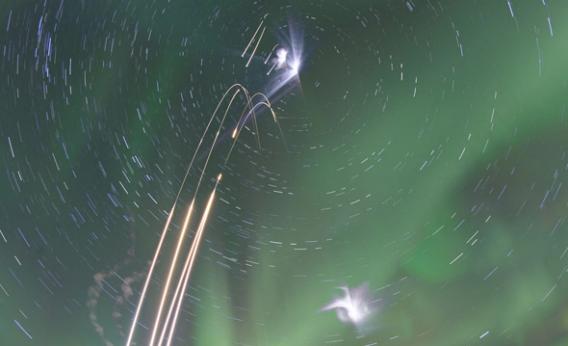Create a free profile to get unlimited access to exclusive videos, sweepstakes, and more!
Laser Rocket Aurora!

This is one of the coolest pictures I’ve ever seen. And bonus: It’s science!
Geez, where to start? OK, this is the Poker Flat Research Range in Alaska, where NASA launches what are called sounding rockets. These are not as big as rockets you might be used to, but they’re still hefty enough to get a payload up as high as 300 kilometers.
On Jan. 26, 2015, four such rockets were launched. In this wide-angle composite picture, you can see the fiery trails of the rocket as they headed skyward (I suspect the exposure started late or was interrupted for the launch on the right, since it starts already off the ground).
In each, you can see where the first stage booster cuts out, and the engine glow gets much dimmer. Then, higher up, the second stage ignites, propelling its payload even higher. The first stage booster continues up on a parabolic arc, then begins to fall. If you trace those arcs down, you’ll even see the impact points on the ground! That’s pretty wild.
The weird feathery glow is part of one of the scientific experiments launched. Called MIST, for Mesospheric Inversion-layer Stratified Turbulence, it releases a compound called tri-methyl aluminum tracer, which creates white expanding clouds. The shape of the cloud can be used to measure the amount of turbulence in the mesosphere, the layer of atmosphere about the stratosphere. The experiment was done in part to see how various molecules in the air are transported vertically in the upper atmosphere.
On the left you can see a green beam; that’s a powerful laser shot up into the air to measure atmospheric conditions at different altitudes.
Of course, the green glowy stuff everywhere is the aurora. And finally, the streaks in the sky are stars! These were time exposures, so the stars moved during the photographs, circling the north pole of the sky (called the celestial pole). Normally you’d see Polaris, the North Star, right in the center of those arcs, but it’s hidden by one of the TMA clouds.
And this gets even better: Here’s stunning video of the whole thing, too:
I love science, I really do. But sometimes, I have to wonder: How much of that is because people get to do really, really cool stuff like this?
Tip o' the nose cone to Wigi Tozzi for the link to the video.


























